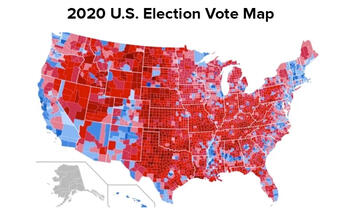
I have been interested in presidential politics and campaigns all my life. I cannot remember an uglier contest, or one with worse candidates, than the one that will be decided on Tuesday. As I explained in August, in “Five Reasons To Be Bullish On The United States,” I am all-day optimistic about the US. We have key advantages over the rest of the world, including world-class education, relatively good demographics, excellent geography and agriculture, cheap energy, and, more than anything, an enduring Constitution.
But we’re cursed with terrible politics and politicians.
What will happen on election day? The vote will almost certainly be close, like it was four years ago, with the outcome determined by a few thousand votes in a handful of states. Nevertheless, I hope that whoever wins, does so bigly. The last thing the US needs right now is a drawn-out process that gets decided by hanging chads.
Chads or no chads, here are my 10 predictions for this election and what we can expect when it’s over (with three charts). Want a preview? The IRA subsidies are here to stay, and the EPA’s EV mandate is dead regardless of who wins.
There are many divisions in America, including race, class, and political affiliation. But the most obvious divide, and it’s one I see when I travel for speaking engagements, is the chasm between urban Americans and their rural counterparts. Rural Americans are more conservative and more religious than folks who live in cities. Voting patterns confirm this. In 2020, Trump won about 2,588 counties, while Biden won 551. Next Tuesday’s results will show a similar outcome.
Milton Friedman famously said there’s “nothing more permanent than a temporary government program.” The renowned economist’s line applies to the Inflation Reduction Act, the measure that was passed by a single vote (cast by Kamala Harris). As the Cato Institute’s Travis Fisher pointed out last year, unless the IRA is reformed or repealed, the climate-related subsidies will be permanent and will cost taxpayers staggering amounts of money over the coming decades. In his piece, Fisher cites an analysis by consulting firm Wood Mackenzie, which concluded that the “real money on the table is on the order of trillions of dollars over multiple decades.”
The idea that the US will spend trillions on alt-energy projects while the deficit is soaring ($35.8 trillion and counting) is the definition of fiscal insanity. But Big Business is feasting on the subsidies, and the most powerful trade associations in Washington have pledged to fight to continue the handouts. Thus, there’s little reason to expect Trump will be able to eliminate the IRA subsidies even if he wants to.
Read the rest of this piece at Robert Bryce Substack.
Robert Bryce is a Texas-based author, journalist, film producer, and podcaster. His articles have appeared in a myriad of publications including the Wall Street Journal, New York Times, Forbes, Time, Austin Chronicle, and Sydney Morning Herald.
Photo: U.S. voting map from 2020, in Public Domain.












